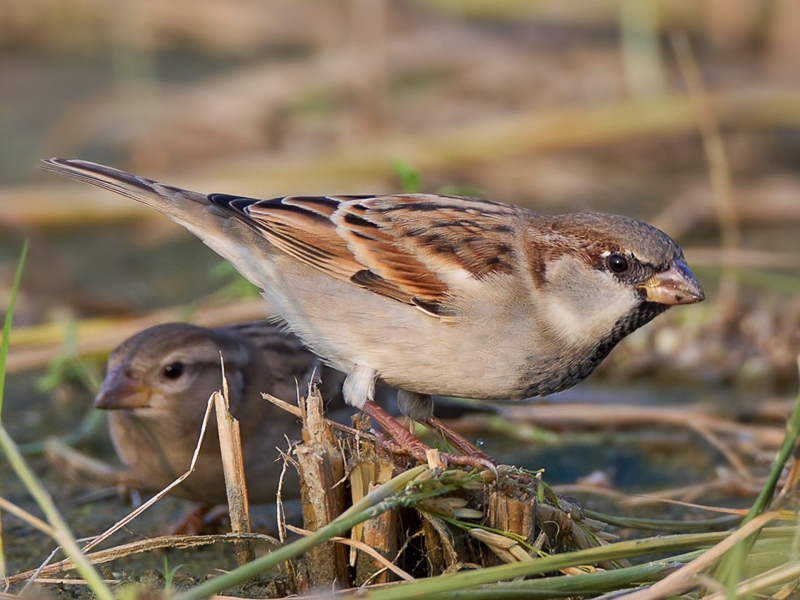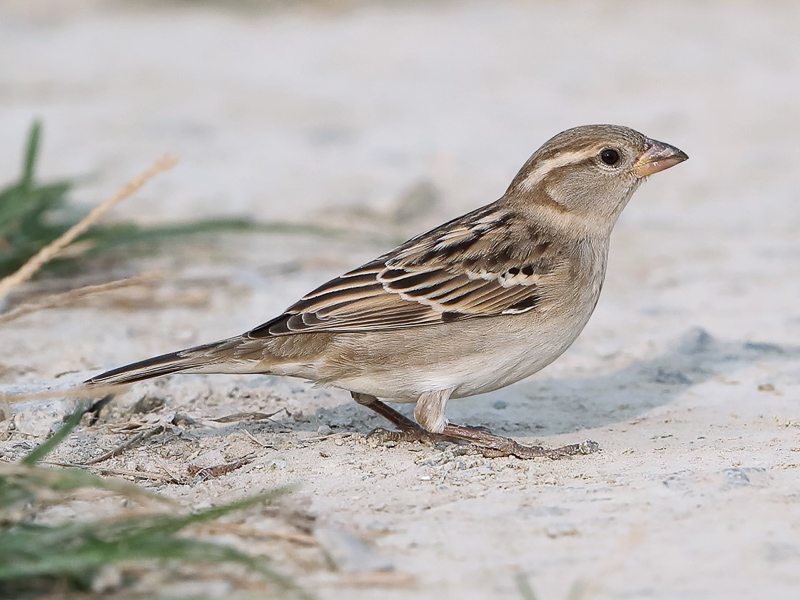House Sparrow Passer domesticus 家麻雀
Category I. Rare autumn passage migrant with ten records, the first in 2012.
IDENTIFICATION

Nov. 2012, Allen Chan.
A robust short-winged sparrow; unlike the similar Eurasian Tree Sparrow but like Russet Sparrow the sexes differ. Males are easily distinguished from these species by its having a grey forecrown extending behind the eye and more extensive black throat patch (extending to the breast in breeding plumage). Like Russet Sparrow it lacks the characteristic black cheek spot shown by Tree Sparrow.

Nov. 2017, Michelle and Peter Wong.
Females must be carefully distinguished from female Russet Sparrows but differ in having paler lores (those of Russet Sparrow are dark) resulting in a more open-faced appearance and a more prominent eye, a weaker buffy supercilium (that of Russet Sparrow is better defined, extends to the lores and is usually broader and whiter) and usually buffier underparts. Structure is also different: House Sparrow has slightly shorter wings and is distinctly longer-tailed than Russet Sparrow.
VOCALISATIONS
In general vocalisations are drier and harsher than those of Eurasian Tree Sparrow.
DISTRIBUTION & HABITAT PREFERENCE
Most observations in HK have come from the farmland and wetland mosaic habitat of Long Valley.
OCCURRENCE
There are ten records, all recent, falling between 20 October and 19 November, as follows:
2012: a male and two females at Long Valley during 3-6 November.
2015: two males at Mai Po NR on 27 October, and a female at Long Valley on 15 November.
2017: a male and two females at Long Valley during 4-19 November.
2018: a male at Long Valley during 5-17 November.
2019: a female at Long Valley on 20 October and two females there during 2-6 November.
2020: a male at Long Valley during 23-24 October, a female at Lok Ma Chau village during 24-25 October and a male, again at Long Valley, on 1 and 5 November.
In addition, a male at Mui Wo on 27 – 30 December 1994 was considered to be likely of captive origin. A female seen on Po Toi on 19 July 2016 showed no evidence of captive origin, but it was considered that in view of the unusual date captive origin could not be ruled out.
The recent increase in records seems likely to reflect the increase and spread in China in recent years (see below).
RANGE & SYSTEMATICS
Found almost worldwide: its original native range extended through most of the Western Palearctic and through the Indian subcontinent. From there it spread as a commensal with man through most of the eastern Palearactic east to Kamchatka and throughout continental southeast Asia (where it was a 20th century arrival). Introduced populations have spread through the entire western hemisphere, Africa, eastern Australia and many oceanic islands. All three subspecies have spread significantly in China in recent years: Cheng (1987) showed it being restricted to exteme western Tibet, northwest Qinghai and northwest Nei Mongol, but Liu and Chen (2021) showed that domesticus has spread into Heilongjiang, bactrianus into Shaanxi and Sichuan, and parkini into Guangxi. This last race is presumably that which has now reached extreme southwest Guangdong where four were photographed on 12 Feb 2019 (eBird 2022).
There are 12 races, three of which occur in China: P. d. domesticus is found in northeast Nei Mongol and Heilongjiang, P. d. bactrianus is distributed through central and southern Xinjiang, Qinghai, Shaanxi and Sichuan, whilst P. b. parkini occurs in southern Tibet, Yunnan and Guangxi (Liu and Chen 2021). Birds seen in HK have not been assigned to race.
CONSERVATION STATUS
IUCN: Least Concern. Population trend decreasing.
Cheng, T. H. (1987). A Synopsis of the Avifauna of China. Science Press, Beijing.
eBird. 2022. eBird: An online database of bird distribution and abundance [web application]. eBird, Cornell Lab of Ornithology, Ithaca, New York. Available: http://www.ebird.org. (Accessed: 26 June 2022).
Liu, Y. and S. H. Chen (eds) (2021). The CNG Field Guide to the Birds of China (in Chinese). Hunan Science and Technology Publication House, Changsha.
Lowther, P. E. and C. L. Cink (2020). House Sparrow (Passer domesticus), version 1.0. In Birds of the World (S. M. Billerman, Editor). Cornell Lab of Ornithology, Ithaca, NY, USA. https://doi.org/10.2173/bow.houspa.01.

